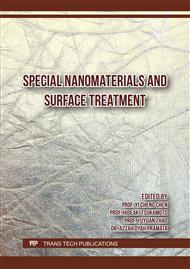[1]
D. Landolt, Fundamental aspects of electropolishing, Electrochim. Acta. 32 (1987) 1–11.
DOI: 10.1016/0013-4686(87)87001-9
Google Scholar
[2]
J.F. Aebersold, P.A. Stadelmann, M. Matlosz, A rotating disk electropolishing technique for TEM sample preparation, Ultramicroscopy. 62 (1996) 157–169.
DOI: 10.1016/0304-3991(95)00144-1
Google Scholar
[3]
S.J. Lee, J.J. Lai, The effects of electropolishing (EP) process parameters on corrosion resistance of 316L stainless steel, J. Mater. Process. Technol. 140 (2003) 206–210.
DOI: 10.1016/S0924-0136(03)00785-4
Google Scholar
[4]
R. Sautebin, H. Froidevaux, D. Landolt, Theoretical and Experimental Modeling of Surface Leveling in ECM under Primary Current Distribution Conditions, J. Electrochem. Soc. 127 (1980) 1096–1100.
DOI: 10.1149/1.2129823
Google Scholar
[5]
P.B. Tailor, A. Agrawal, S.S. Joshi, Evolution of electrochemical finishing processes through cross innovations and modeling, Int. J. Mach. Tools Manuf. 66 (2013) 15–36.
DOI: 10.1016/j.ijmachtools.2012.11.005
Google Scholar
[6]
C. Rotty, A. Mandroyan, M.L. Doche, J.Y. Hihn, Electropolishing of CuZn brasses and 316L stainless steels: Influence of alloy composition or preparation process (ALM vs. standard method), Surf. Coat. Technol. 307 (2016) 125–135.
DOI: 10.1016/j.surfcoat.2016.08.076
Google Scholar
[7]
L.M.A. Monzon, V. Nair, B. Reilly, J.M.D. Coey, Magnetically-Induced Flow during Electropolishing, J. Electrochem. Soc. 165 (2018) E679–E684.
DOI: 10.1149/2.0581813jes
Google Scholar
[8]
W. Han, F. Fang, Fundamental aspects and recent developments in electropolishing, Int. J. Mach. Tools Manuf. 139 (2019) 1–23.
DOI: 10.1016/j.ijmachtools.2019.01.001
Google Scholar
[9]
B. Arifvianto, Suyitno, M. Mahardika, Surface morphology, roughness and wettability of the medical grade 316L stainless steel processed with surface mechanical attrition treatment and electropolishing for the preparation of osteosynthesis plate, J. Phys. Sci. 29 (2018) 83–94.
DOI: 10.21315/jps2018.29.3.7
Google Scholar
[10]
B. Arifvianto, M. Mahardika, U.A. Salim, S. Suyitno, The influence of SMAT and polishing on the degradation of AZ31B magnesium alloy in 3.5 wt.% NaCl solution, Key Eng. Mater. 840 KEM (2020) 377–382.
DOI: 10.4028/www.scientific.net/kem.840.377
Google Scholar
[11]
T. Hryniewicz, Concept of microsmoothing in the electropolishing process, Surf. Coatings Technol. 64 (1994) 75–80.
DOI: 10.1016/S0257-8972(09)90006-8
Google Scholar
[12]
Y.-C. Wu, C.-N. Kuo, Y.-C. Chung, C.-H. Ng, J.C. Huang, Effects of Electropolishing on Mechanical Properties and Bio-Corrosion of Ti6Al4V Fabricated by Electron Beam Melting Additive Manufacturing, Materials, 12 (2019) 1466.
DOI: 10.3390/ma12091466
Google Scholar
[13]
E.S. Lee, Machining characteristics of the electropolishing of stainless steel (STS316L), Int. J. Adv. Manuf. Technol. 16 (2000) 591–599.
DOI: 10.1007/s001700070049
Google Scholar
[14]
A. Chandra, M. Sumption, G.S. Frankel, On the Mechanism of Niobium Electropolishing, J. Electrochem. Soc. 159 (2012) C485–C491.
DOI: 10.1149/2.054211jes
Google Scholar
[15]
B. Chatterjee, Science and industry of electropolishing, Jahrbuch Oberflächentechnik, 71 (2015) 77-93.
Google Scholar
[16]
T. Maciąg, J. Wieczorek, B. Węcki, Parameters selection for electropolishing process of products made of copper and its alloys, Arch. Metall. Mater. (2017)
DOI: 10.1515/amm-2017-0223
Google Scholar
[17]
M. Al-Ajlouni, A. Al-Hamdan, Designing, building and testing of an electropolishing cell, J. Appl. Sci. 8 (2008) 1912–1918.
DOI: 10.3923/jas.2008.1912.1918
Google Scholar
[18]
P. Lochyński, S. Charazińska, E. Łyczkowska-Widłak, A. Sikora, Electropolishing of stainless steel in laboratory and industrial scale, Metals (Basel). 9 (2019) 1–15.
DOI: 10.3390/met9080854
Google Scholar
[19]
M. Datta, D. Landolt, Fundamental aspects and applications of electrochemical microfabrication, Electrochim. Acta. 45 (2000) 2535–2558.
DOI: 10.1016/S0013-4686(00)00350-9
Google Scholar
[20]
E.S. Lee, T.H. Shin, An evaluation of the machinability of nitinol shape memory alloy by electrochemical polishing, J. Mech. Sci. Technol. 25 (2011) 963–969. https://doi.org/.
DOI: 10.1007/s12206-011-0209-2
Google Scholar
[21]
L. Yang, Y. Wu, A. Lassell, B. Zhou, Electropolishing of Ti6Al4V parts fabricated by electron beam melting, Solid Free. Fabr. 2016 Proc. 27th Annu. Int. Solid Free. Fabr. Symp. - An Addit. Manuf. Conf. SFF 2016. (2016) 1333–1344.
Google Scholar
[22]
M. Matlosz, Modeling of impedance mechanisms in electropolishing, Electrochim. Acta. 40 (1995) 393–401.
DOI: 10.1016/0013-4686(94)00287-B
Google Scholar
[23]
E. Łyczkowska-Widłak, P. Lochyński, G. Nawrat, Electrochemical polishing of austenitic stainless steels, Materials (Basel). 13 (2020) 1–25.
DOI: 10.3390/ma13112557
Google Scholar
[24]
M. Haïdopoulos, S. Turgeon, C. Sarra-Bournet, G. Laroche, D. Mantovani, Development of an optimized electrochemical process for subsequent coating of 316 stainless steel for stent applications, J. Mater. Sci. Mater. Med. 17 (2006) 647–657.
DOI: 10.1007/s10856-006-9228-4
Google Scholar
[25]
H. Hocheng, P.S. Kao, Y.F. Chen, Electropolishing of 316L stainless steel for anticorrosion passivation, J. Mater. Eng. Perform. 10 (2001) 414–418. https://doi.org/.
DOI: 10.1361/105994901770344827
Google Scholar
[26]
G.M. Tsoeunyane, N. Mathe, L. Tshabalala, M.E. Makhatha, Electropolishing of Additively Manufactured Ti-6Al-4V Surfaces in Nontoxic Electrolyte Solution, Adv. Mater. Sci. Eng. 2022 (2022) 1–12.
DOI: 10.1155/2022/6987353
Google Scholar
[27]
T.S. Hahn, A.R. Marder, Effect of electropolishing variables on the current density-voltage relationship, Metallography. 21(1988) 365-375.
DOI: 10.1016/0026-0800(88)90001-8
Google Scholar
[28]
G.H. Sedahmed, M.S. Abdo, M.A. Kamal, O.A. Fadaly, H.M. Osman, Effect of gas sparging on the rate of mass transfer during electropolishing of vertical plates, Chem. Eng. Process. 40 (2001) 195–200.
DOI: 10.1016/S0255-2701(00)00109-4
Google Scholar
[29]
L. Yang, H. Gu, A. Lassell, Surface treatment of Ti6Al4V parts made by powder bed fusion additive manufacturing processes using electropolishing, 25th Annu. Int. Solid Free. Fabr. Symp.: An Addit. Manuf. Conf. SFF 2014. (2014) 268–277.
Google Scholar
[30]
Y. Wei, X. Fang, N. Qu, D. Zhu, Effects of electrolyte flushing and surface state on electropolishing TB2 titanium alloy, Int. J. Adv. Manuf. Technol. 119 (2022) 7865–7874.
DOI: 10.1007/s00170-022-08754-8
Google Scholar
[31]
L. Yang, C.O. Neil, Y. Wu, the use of electropolishing surface treatment on In 718 parts fabricated by laser powder bed fusion process, Solid Free. Fabr. 2017 Proc. 28th Annual Int. Solid Free. Fabr. Symp.: An Addit. Manuf. Conf. SFF 2017. 2493–2502.
Google Scholar



